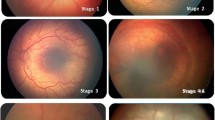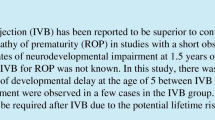Abstract
Purpose
To compare the anterior and posterior segment complications of diode (810 nm) laser photocoagulation (LPC) and Nd:YAG (532 nm green) LPC in the treatment of retinopathy of prematurity (ROP).
Patients and methods
The 84 eyes of 43 patients treated with diode LPC (group 1) and 58 eyes of 31 patients treated with Nd:YAG LPC (group 2) for ROP in our clinic were enrolled in the study. Medical records of all patients were investigated retrospectively. The patients in each group were examined in terms of birth weights, gestational weeks, stage of retinopathy, number of lasers pots, laser parameters, and anterior and posterior complications of LPC.
Results
The mean birth weeks of group 1 patients were postmenstrual 27.7 ± 2.5 (23–33), while the mean birth weights were 1006.0 ± 334.5 (540–1980) grams. The mean birth weeks of group 2 patients were postmenstrual 27.4 ± 2.6 (23–33), while the mean birth weights were 1073.8 ± 329.2 (480–1720) grams. The mean numbers of laser spots were 1036.0 ± 515.2 (430–2410) in group 1 per eye, while the mean numbers of laser spots were 1085.4 ± 526.0 (445–2530) in group 2 per eye (p ≥ 0.05). Additional laser application was performed in four eyes (4.8%) in group 1 and four eyes (6.9%) in group 2. Four eyes (4.8%) treated with diode LPC and one eye (1.7%) treated with Nd:YAG laser developed retinal detachment. Two eyes of a patient (3.4%) applied Nd:YAG LPC developed cataract.
Conclusion
Cataract may develop when Nd:YAG laser is used; however, posterior segment complications may be more likely to appear with the use of diode laser in these cases.

Similar content being viewed by others
References
BOOST II United Kingdom Collaborative Group, BOOST II Australia Collaborative Group, BOOST II New Zealand Collaborative Group (2013) Oxygen saturation and outcomes in preterm infants. N Engl J Med 368(22):2094–2104
Palmer EA, Flynn JT, Hardy RJ, Phelps DL, Phillips CL, Schaffer DB, Tung B (1991) Incidence and early course of retinopathy of prematurity. The Cryotherapy for Retinopathy of Prematurity Cooperative Group. Ophthalmology 98(11):1628–1640
Good WV, Hardy RJ, Dobson V, Palmer EA, Phelps DL, Quintos M, Tung B, Early Treatment for Retinopathy of Prematurity Cooperative Group (2005) The incidence and course of retinopathy of prematurity: findings from the early treatment for retinopathy of prematurity study. Pediatrics 116(1):15–23
Gnanaraj L, Brennan R, Cottrell DG (2003) Retinopathy of prematurity in practice. II: long-term results following treatment for threshold disease. Eye (Lond) 17(2):189–193
Sanghi G, Dogra MR, Vinekar A, Gupta A (2010) Frequency-doubled Nd:YAG (532nm green) versus diode laser (810nm) in treatment of retinopathy of prematurity. Br J Ophthalmol 94(9):1264–1265
Roohipoor R, Karkhaneh R, Esfahani MR, Alipour F, Haghighat M, Ebrahimiadib N, Zarei M, Mehrdad R (2016) Comparison of refractive error changes in retinopathy of prematurity patients treated with diode and red lasers. Ophthalmologica 235(3):173–178
Kashiwagi S, Brauns T, Gelfand J, Poznansky MC (2014) Laser vaccine adjuvants. History, progress and potential. Hum Vaccin Immunother 10(7):1892–1907
Capone A Jr, Drack AV (1994) Transient lens changes after diode laser retinal photoablation for retinopathy of prematurity. Am J Ophthalmol 118(4):533–534
International Committee for the Classification of Retinopathy of Prematurity (2005) The international classification of retinopathy of prematurity revisited. Arch Ophthalmol 123(7):991–999
Early Treatment For Retinopathy Of Prematurity Cooperative Group (2003) Revised indications for the treatment of retinopathy of prematurity: results of the early treatment for retinopathy of prematurity randomized trial. Arch Ophthalmol 121(12):1684–1694
Salgado CM, Çelik Y, Vanderveen DK (2010) Anterior segment complications after diode laser photocoagulation for prethreshold retinopathy of prematurity. Am J Ophthalmol 150(1):6–9
Günay M, Şekeroğlu MA, Çelik G, Gunay BO, Unlu C, Ovali F (2015) Anterior segment ischemia following diode laser photocoagulation for aggressive posterior retinopathy of prematurity. Graefes Arch Clin Exp Ophthalmol 253(6):845–848
Davitt BV, Christiansen SP, Hardy RJ, Tung B, Good WV (2013) Incidence of cataract development by 6 months’ corrected age in the Early Treatment for Retinopathy of Prematurity study. JAAPOS 17(1):49–53
Pogrebniak AE, Bolling JP, Stewart MW (1994) Argon laser-induced cataract in an infant with retinopathy of prematurity. Am J Ophthalmol 117(2):261–262
Lambert SR, Capone A, Cingle KA, Drack AV (2000) Cataract and phthisis bulbi after laser photoablation for threshold retinopathy of prematurity. Am J Ophthalmol 129(5):585–591
Paysse EA, Miller A, Brady McCreery KM, Coats DK (2002) Acquired cataracts after diode laser photocoagulation for threshold retinopathy of prematurity. Ophthalmology 109(9):1662–1665
Ehmann D, Greve M (2014) Intravitreal bevacizumab for exudative retinal detachment post laser therapy for retinopathy of prematurity. Can J Ophthalmol 49(2):228–231
Armada-Maresca F, Peralta-Calvo J, Pastora-Salvador N, Grabowska A, Vallejo-Garcia J (2014) External subretinal drainage bevacizumab, and scleral buckling for complete exudative retinal detachment after photocoagulation in retinopathy of prematurity. Retin Cases Brief Rep 8(1):33–36
Moshfeghi DM, Silva RA, Berrocal AM (2014) Exudative retinal detachment following photocoagulation in older premature infants for retinopathy of prematurity: description and management. Retina 34(1):83–86
Mintz-Hittner HA, Kuffel RR Jr (2008) Intravitreal injection of bevacizumab (avastin) for treatment of stage 3 retinopathy of prematurity in zone I or posterior zone II. Retina 28(6):831–838
Repka MX, Tung B, Good WV, Capone A Jr, Shapiro MJ (2011) Outcome of eyes developing retinal detachment during the early treatment for retinopathy of prematurity study. Arch Ophthalmol 129(9):1175–1179
Benner JD, Huang M, Morse LS, Hjelmeland LM, Landers MB 3rd (1992) Comparison of photocoagulation with the argon, krypton, and diode laser indirect ophthalmoscopes in rabbit eyes. Ophthalmology 99(10):154–163
Zhang G, Yang M, Zeng J, Vakros G, Su K, Chen M, Li H, Tian R, Li N, Tang S, He H, Tan W, Song X, Zhuang R, Shenzhen Screening for Retinopathy of Prematurity Cooperative Group (2017) Comparison of intravitreal injection of Ranibizumab versus laser therapy for zone ii treatment-requiring retinopathy of prematurity. Retina 37(4):710–717
Lyu J, Zhang Q, Chen C, Xu Y, Ji X, Zhao P (2019) Ranibizumab injection and laser photocoagulation to treat type 1 retinopathy of prematurity after 40 weeks post menstrual age: a retrospective case series study. BMC Ophthalmol 19(1):60
Banach MJ, Berinstein DM (2001) Laser therapy for retinopathy of prematurity. Curr Opin Ophthalmol 12(3):164–170
Lira RPC, Calheiros ABM, Barbosa MMVC, Oliveira CV, Viana SL, Lima DC (2008) Efficacy and safety of green laser photocoagulation for threshold retinopathy of prematurity. Arq Bras Oftalmol 71(1):49–51
Cuthbertson F, Newsom R (2007) UK retinopathy of prematurity treatment survey. Eye 21(2):156–157
Chhabra K, Kaur P, Singh K, Aggarwal A, Chalia D (2018) Outcome of solid-state 532 nm green laser in high-risk retinopathy of prematurity at a tertiary care centre in India. Int Ophthalmol 38(1):287–291
Author information
Authors and Affiliations
Corresponding author
Ethics declarations
The retrospective study has received Institutional Review Board/Ethics Committee approval and adhered to the tenets of the Declaration of Helsinki.
Conflict of interest
The authors declare that they have no conflict of interest.
Additional information
Publisher’s note
Springer Nature remains neutral with regard to jurisdictional claims in published maps and institutional affiliations.
Rights and permissions
About this article
Cite this article
Dikci, S., Demirel, S., Fırat, P.G. et al. Comparison of Nd:YAG laser (532 nm green) vs diode laser (810 nm) photocoagulation in the treatment of retinopathy of prematurity: an evaluation in terms of complications. Lasers Med Sci 35, 1323–1328 (2020). https://doi.org/10.1007/s10103-019-02918-x
Received:
Accepted:
Published:
Issue Date:
DOI: https://doi.org/10.1007/s10103-019-02918-x




